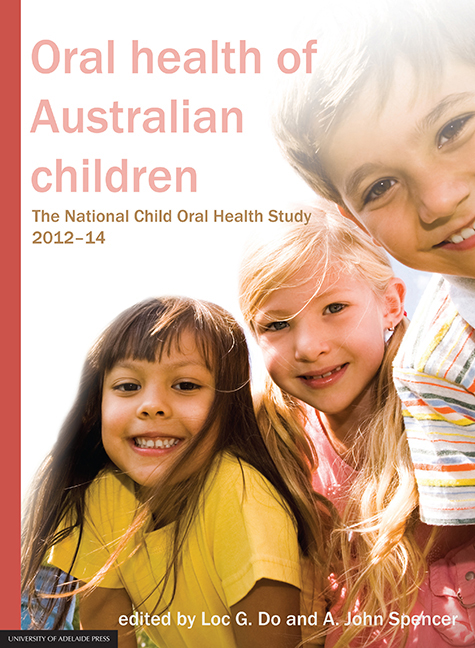Book contents
- Frontmatter
- List of Contributors
- Contents
- Preface
- Executive Summary
- 1 Children's oral health – assessing and improving oral health
- 2 Measuring child oral health and its influences
- 3 Data weighting, consideration and estimation procedures
- 4 Measuring representativeness of the study participants
- 5 Children's oral health status in Australia, 2012–14
- 6 Patterns of dental services use by Australian children
- 7 Australian children's oral health behaviours
- 8 Australian children's general health behaviours
- 9 Social gradients in child oral health
- 10 Oral health status and behaviours of Indigenous Australian children
- 11 Trends in child oral health in Australia
- 12 Interpretation of findings and a way forward to improving oral health and dental care
- 13 Appendix
- State and territory survey personnel
- Symbols
- Abbreviations
- Place names
- Glossary
- List of tables
- List of figures
12 - Interpretation of findings and a way forward to improving oral health and dental care
Published online by Cambridge University Press: 05 September 2017
- Frontmatter
- List of Contributors
- Contents
- Preface
- Executive Summary
- 1 Children's oral health – assessing and improving oral health
- 2 Measuring child oral health and its influences
- 3 Data weighting, consideration and estimation procedures
- 4 Measuring representativeness of the study participants
- 5 Children's oral health status in Australia, 2012–14
- 6 Patterns of dental services use by Australian children
- 7 Australian children's oral health behaviours
- 8 Australian children's general health behaviours
- 9 Social gradients in child oral health
- 10 Oral health status and behaviours of Indigenous Australian children
- 11 Trends in child oral health in Australia
- 12 Interpretation of findings and a way forward to improving oral health and dental care
- 13 Appendix
- State and territory survey personnel
- Symbols
- Abbreviations
- Place names
- Glossary
- List of tables
- List of figures
Summary
The genesis of this research was the need to describe and understand contemporary child oral health in Australia. The population study provided an opportunity to collect detailed information on both oral epidemiological and self-reported oral health indicators on a representative sample of the Australian child population. It also provided the opportunity to accompany those indicators with a rich array of individual, family and community characteristics that positioned every child in terms of their social milieu, behavioural risk and preventive factors and use of dental services for both treatment of existing disease and prevention of future disease.
The sampling strategy for the study was built around the capacity for all states and territories to have sufficient confidence in their estimates of child oral health. As a consequence, the study was really eight separate sub-studies then rolled together to constitute a large national oral epidemiological study. The sampling strategy had as its foundation cluster sampling of children from selected schools across all regions of the country. The probability of every child's selection was known, allowing for each child's contribution to the findings of the study to be weighted to reflect equal probabilities of selection in the sample and the population distribution of children with similar characteristics. The outcome of the complex weighting procedures was a data set that showed negligible bias against the population at large. Therefore, there is confidence in unbiased estimates of child oral health.
Every effort was made to collect high quality oral health information through the use of small teams of calibrated dental examiners, well supported with written and visual materials to aid standardised scoring, and with appropriate refresher activities during the fieldwork. The reliability statistics attest the success in this endeavour at least for the more frequently observed oral health indicators.
The accompanying data from a detailed parental questionnaire was strong in its depth. Yet, parents provided complete data with only a few exceptions. Household income was the item for which there was the most missing data, but even here the level of missing data was relatively low and an alternative marker for social position, highest parental education, was very largely complete.
- Type
- Chapter
- Information
- Oral Health of Australian ChildrenThe National Child Oral Health Study 2012-14, pp. 306 - 321Publisher: The University of Adelaide PressPrint publication year: 2016



